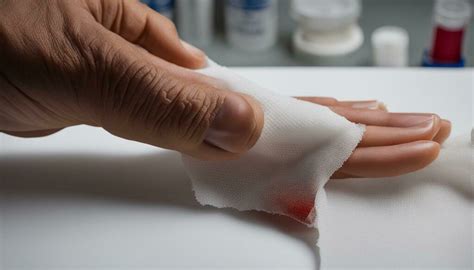Gentle Gauze Removal: Protecting Your Skin and Promoting Healing
Removing gauze dressings can seem like a simple task, but improper technique can lead to pain, skin damage, and delayed healing. Gentle gauze removal is crucial for maintaining skin integrity and promoting a healthy healing process. This comprehensive guide will walk you through the best practices for removing gauze, addressing common concerns and providing valuable tips for optimal wound care.
Why Gentle Gauze Removal Matters
Your skin, especially when wounded, is delicate. Aggressive removal of gauze can disrupt the healing process by:
- Damaging new skin cells: Pulling or ripping gauze can tear fragile new tissue, delaying healing and potentially causing scarring.
- Increasing pain and discomfort: Forceful removal is inherently painful and can traumatize the wound site, increasing inflammation and discomfort.
- Increasing the risk of infection: Damaged skin is more susceptible to infection. Gentle removal minimizes the risk of introducing bacteria into the wound.
- Promoting bleeding: Rough handling can dislodge blood clots and restart bleeding, hindering the healing process.
How to Remove Gauze Gently: A Step-by-Step Guide
The key to gentle gauze removal is patience and the right technique. Here's a step-by-step guide:
-
Preparation: Gather your supplies: clean gloves, sterile saline solution (or water as directed by your healthcare provider), fresh gauze pads, and possibly wound care ointment (as directed). Ensure good lighting.
-
Soak the Gauze: Gently pour sterile saline solution or water over the gauze dressing to soften the adhesive and allow it to loosen. Allow it to soak for several minutes. This is especially important for dressings that have dried or adhered strongly to the wound.
-
Slow and Steady Removal: Using clean gloved hands, gently begin to lift one edge of the gauze. Avoid pulling or jerking. If the gauze is stuck, use a slow, deliberate peeling motion, working your way around the wound. If it's particularly stubborn, apply more saline solution.
-
Monitor for Bleeding: Observe the wound for any signs of bleeding. If bleeding occurs, apply gentle pressure with a clean gauze pad until it stops. If bleeding is excessive or persistent, seek medical attention.
-
Wound Assessment: Once the gauze is removed, assess the wound for any signs of infection (redness, swelling, pus, increased pain). Clean the wound as directed by your healthcare provider.
-
Apply New Dressing: Apply a fresh, clean dressing and any necessary wound care ointment as advised by your doctor or nurse.
What if the Gauze is Stuck?
If the gauze is firmly adhered to the wound, resist the urge to pull. Try the following:
- More Saline: Apply more saline solution and allow it to soak for longer.
- Warm Compress: A warm, damp compress can help soften the adhesive.
- Petroleum Jelly: A thin layer of petroleum jelly can help lubricate the gauze and make it easier to remove.
When to Seek Medical Attention
While gentle gauze removal is typically straightforward, seek medical attention if you experience:
- Excessive bleeding: Bleeding that doesn't stop after applying pressure.
- Signs of infection: Increased pain, redness, swelling, pus, or fever.
- Severe pain: Intolerable pain during gauze removal.
- Difficulty removing the dressing: If you're unable to remove the gauze gently despite trying multiple methods.
How Often Should I Change My Gauze?
The frequency of gauze changes depends on the type of wound, the dressing used, and your healthcare provider's instructions. Always follow your doctor's or nurse's advice regarding dressing changes.
What Type of Gauze is Best for Wound Care?
Different types of gauze serve different purposes. Consult your healthcare provider for guidance on the most appropriate type of gauze for your specific wound.
Can I Use Petroleum Jelly to Remove Stuck Gauze?
Yes, a small amount of petroleum jelly can help lubricate the gauze and make removal easier. However, avoid using excessive amounts, as this could interfere with wound healing.
What Should I Do if I Accidentally Damage My Skin While Removing Gauze?
If you accidentally damage your skin, clean the area gently with sterile saline solution, apply a clean dressing, and contact your healthcare provider.
By following these guidelines and prioritizing gentle techniques, you can ensure optimal wound care, minimize discomfort, and promote faster, healthier healing. Remember, patience and careful attention to detail are key to successful gauze removal.

